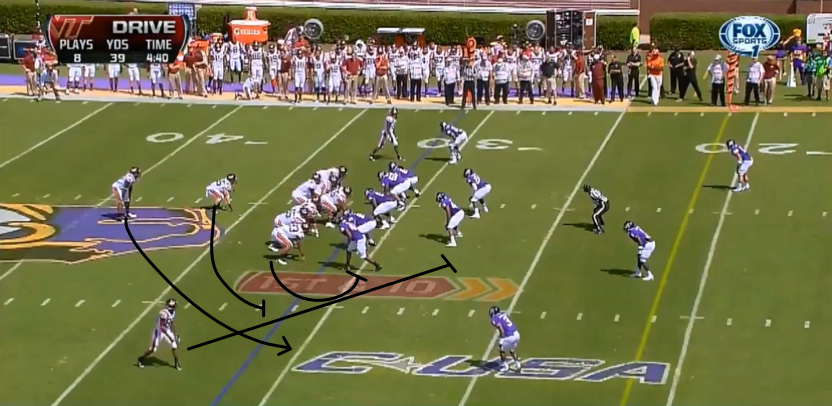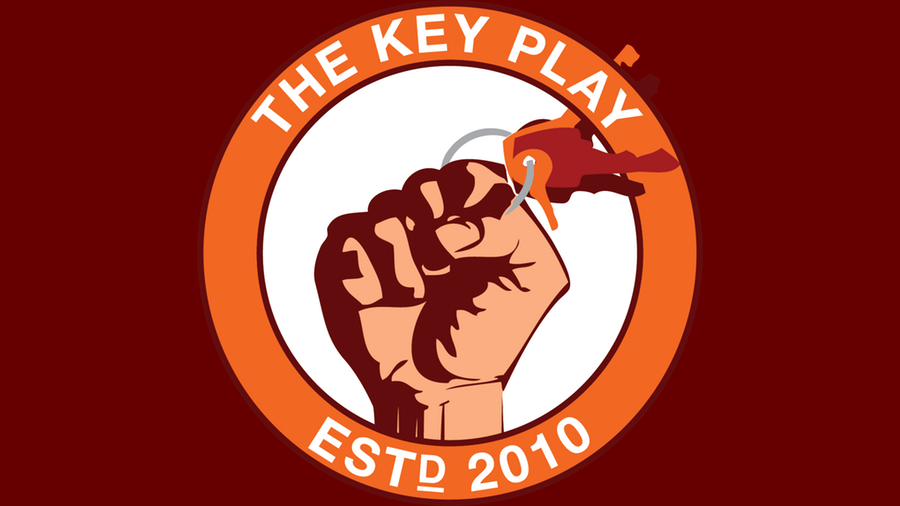One of the bright spots this young season has been the excellent performance by the offensive line. I was thrilled with their execution and noticeably improved fundamentals. My one reservation was the matchups. Alabama has an elite, very athletic front, but their system requires their defensive line to engage blockers, allowing their linebackers to make plays. Western Carolina was completely out manned. Both teams used a relatively static concept up front designed to occupy blockers.
East Carolina presented a very different challenge. Could the Hokies offensive line be effective against a quick defensive front that is focused more on attacking the gaps and stunting than maintaining gap fits? The Pirates used a 3-man defensive front that they flexed over to the strong side of the offensive line. To the weak side, the "jack" linebacker aligned as a stand-up defensive end. The inside linebackers aligned well off the line of scrimmage. The added distance gave the linebackers a distinct quickness advantage over the offensive linemen trying to get to the second level. To the strong side, the Pirates completed the 3-4 look with an outside linebacker who usually aligned well off the line of scrimmage, almost in a nickel alignment.
The Pirates philosophy was focused on stopping the running game. The Pirates used 8-man fronts late in the game. However, for three quarters their scheme devised to stop the inside zone with their front-six, and then bringing the strong side outside linebacker and a safety up on the edge to clean up any cutback lanes and take away runs outside the tackles. The front-six completely ignored the threat of either the outside stretch or a bootleg. Instead, their front was clearly instructed to resist being moved laterally, and to plant their outside leg and cross the face of their blocker, while their middle linebackers attacked cutback lanes rather than moving laterally to avoid being reached by blockers going to the second level. Let's take a look at an example of how these techniques caused problems for the Hokie blockers.
On this play, the Hokies run the basic inside zone from the I-formation with a fullback lead. As previously discussed, each offensive lineman steps hard to the play side in an effort to drive the defensive line parallel to the line of scrimmage while creating a small cutback bubble for Trey Edmunds to hit.
00:03:32–00:03:37
David Wang takes a terrific initial step, driving the nose tackle a yard to the right and getting his head on the left side of the defender to create a cut lane back side. Fullback Sam Rogers sees the bubble, and leads through on the linebacker. But, at this critical moment, the play loses steam.
The defensive tackle, 6-1, 322-pound junior Terry Williams, plants his outside leg and crosses back across Wang's face. This is an incredibly athletic play (one of many Williams made throughout the game), made easier by Wang's inability to capitalize on the initial push and continue to drive him to the sideline. On the other side, Jonathan McLaughlin (who struggled both sealing the back side on zone runs and pass protection) is beaten inside by jack linebacker Derrell Johnson. He has to either get inside of Johnson and seal him outside, or drive him across the hole. McLaughlin gets caught in between, and makes the tackle with Williams closing in from the other side.
Now, rewind and watch both middle linebackers. Andrew Miller takes a hard outside step designed to reach the inside linebacker on the outside. Normally, that linebacker would sprint to the outside to protect against being sealed inside on an outside stretch, but here (and many other plays) the linebacker takes one step and ignores the threat of outside stretch and shoots the interior gaps. This leaves Miller (who did everything correctly) looking somewhat silly with nobody to block. The Pirates also brought a corner blitz from the boundary to account for bootleg.
Miller hinted at the linebacker's technique after the game.
"We weren't creating enough space on the zone, getting to our aiming points right and climbing to the linebackers," Miller said. "They were backdooring us a lot of times, so we've just got to be better at that, creating space down the line with this wide zone."
This scenario, with ECU's linebackers reading and attacking the inside zone, the defensive line bouncing off blocks back to the inside, and an 8th man coming into the box late from the secondary, was ongoing throughout the afternoon. I thought that perhaps Scot Loeffler could have made the inside zone more effective by mixing in more outside stretch to force those inside linebackers and interior linemen to respect the possibility of a reach block. Looking at the formation, if the tight end could seal the edge, the wide side of the field appears to be very susceptible to the stretch play.

While an outside stretch can be cut up quickly to the inside, the run is designed to attack the edge and then look for a cutback lane. On film, I try to look at the aiming points of the offensive line to determine if the call is an inside zone or outside zone. On inside zones, I expect the guards to get their heads on the inside shoulder of the defender and drive them to the sideline. On outside zones, I look for more of a reach block, with the guards attempting to get their heads on the outside shoulder of a defender.
While some of the early Virginia Tech runs may have been outside stretch plays that Edmunds and Mangus cut back inside, I could not clearly identify a true outside stretch until the fourth quarter.
00:17:21–00:17:28
While this run resulted in a relatively short gain (3 yards), it forces the defense to respect the threat to the outside. If the stretch was called, the backs need to recognize that there are more soft spots than just cutting right off the center. Running the outside stretch and attacking the edge forces those linebackers to move laterally rather than attack the line, and when the Pirate linebackers moved laterally against inside zone, Edmunds had three nice runs. Here is one example.
00:10:37–00:10:44
On this play, the right inside linebacker moves laterally towards the sidelines. Fullback Sam Rogers leads into the hole, and reads the linebacker moving to the outside. Rogers attacks the inside shoulder and turns him out, and Edmunds reads the cutback perfectly.
Still, despite all the struggles, the Hokies were able to scrape together just enough rushing yards to put the passing attack in serviceable down and distance situations. Despite losing some battles, the compete level was high. Jonathan McLaughlin had some struggles dealing with the bull rush off the edge, but he battled right to the whistle. He was also tremendous getting out in front of screens (as was the rest of the line). Give him a year in the strength and conditioning program and he won't lose his ground to a defender attacking him fullsteam straight ahead. David Wang had a tough day too, but that nose tackle played much better than his counterpart for Alabama. Unlike last year, I didn't see Wang losing contact and then watching his back get hit. He stayed engaged even after losing leverage. Pass protection besides McLaughlin was excellent. It wasn't as bad as the numbers would indicate, but there is room for improvement.
Again, I think every game will be a bit of a struggle on offense. Inexperience at the skill positions puts even more pressure on the offensive line to be perfect, and they are new to this system as well. They have to get better, and I expect they will.


Comments
Please join The Key Players Club to read or post comments.
Please join The Key Players Club to read or post comments.
Please join The Key Players Club to read or post comments.
Please join The Key Players Club to read or post comments.
Please join The Key Players Club to read or post comments.
Please join The Key Players Club to read or post comments.
Please join The Key Players Club to read or post comments.
Please join The Key Players Club to read or post comments.
Please join The Key Players Club to read or post comments.
Please join The Key Players Club to read or post comments.
Please join The Key Players Club to read or post comments.
Please join The Key Players Club to read or post comments.
Please join The Key Players Club to read or post comments.
Please join The Key Players Club to read or post comments.
Please join The Key Players Club to read or post comments.
Please join The Key Players Club to read or post comments.
Please join The Key Players Club to read or post comments.
Please join The Key Players Club to read or post comments.
Please join The Key Players Club to read or post comments.
Please join The Key Players Club to read or post comments.